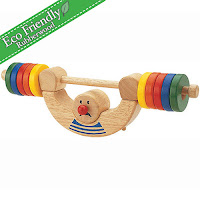A friend recently asked me if I had any ideas for
kids games, prizes and fun stuff to do at a birthday party she is hosting for her little man who is turning 4. He loves pirates so I put my teachers thinking cap on and came up with some themed pirate activities, games, gifts and prizes that I know will go down a treat with a group of young pirates!
Of course a themed pirate party would be nothing without
kids dress ups. Guests could come already dressed up or you could have a dress up/costume treasure chest at your front door with pirate shirts, bandanas, hats, eye patches, etc that guests could dress in as they enter.
Game Idea 1: Pin the Parrot on the Pirate
Draw or download and print a picture of a pirate on a large piece of paper. Then draw or print out several parrot pictures that are small enough to fit on your pirates shoulder.
Play by the rules of Pin the Tail on the Donkey.
Game Idea 2: Island, Island, Treasure!
This
kids game is a pirate take on the game Duck, Duck, Goose. All children sit in a circle facing inwards. A person is chosen to be the pirate and wears a pirate hat. These instructions are written from the point of view of the pirate.
Walk around the outside of the circle, lightly tapping each person on the shoulder as you pass by. As you tap each person, say the word "Island." Those that are named islands remain sitting down.
As you are walking around, decide on the person that you want to be the next “Pirate” and when you tap them say “Treasure” instead of “Island”. This person must stand up quickly and chase you around the circle. When you reach the “Treasure’s” former seat sit down before they can tag you, the person named “Treasure” then becomes the “Pirate”. Keep playing until everyone has had a turn or 2. There are no winners in this game so it can be played without prizes or everyone can get a small prize at the end for their effort.
Game Idea 3: Pass the Treasure
Wrap up a home-made treasure chest filled with prizes such as lollies, chocolates or small toys. Also include a larger toy for the winner of the game. Play like pass the parcel. When the winner opens the treasure chest they keep the large toy and can share the smaller prizes with everyone.
Game Idea 4: Pirate Treasure Hunt
Place small toys, prizes, chocolate coins, etc in loot bags (these could be small brown paper bags with a skull and cross bones drawn or painted on). Hide them around your house or backyard. Before the hunt show the guests an example of the loot bags they are looking for on the treasure hunt so they aren’t collecting random things from around your home or yard.
For younger children, hide loot bags around the yard/house and go on a treasure hunt.
For older children, draw a simple map of your backyard/house. Then draw X’s in the places you have hidden treasure for guests to collect during the treasure hunt. Make a copy for each player and off you go.



































